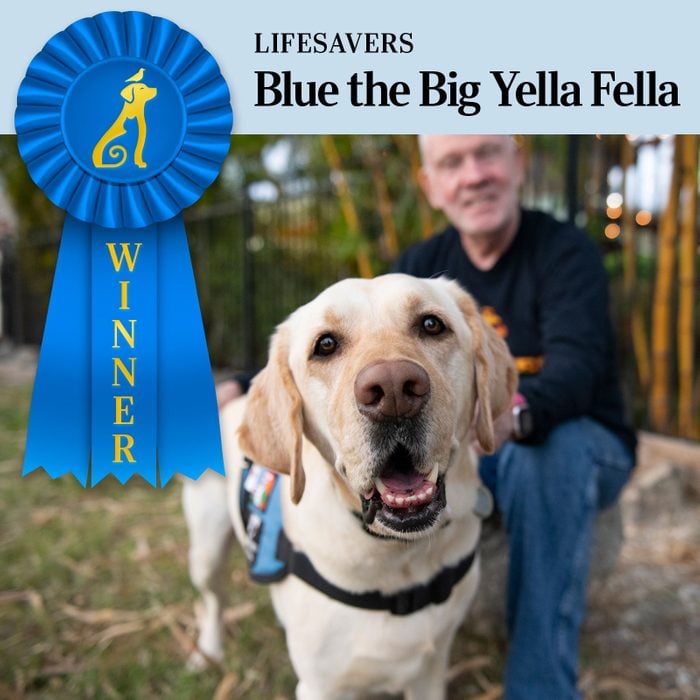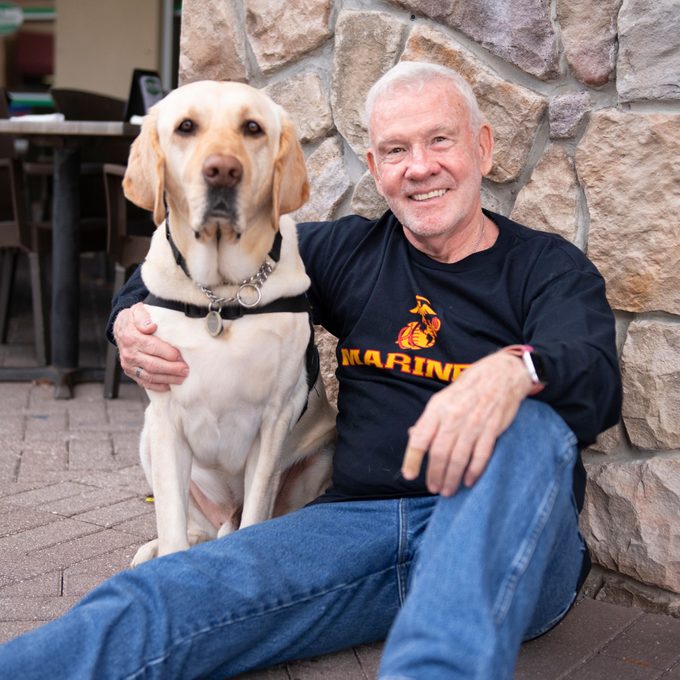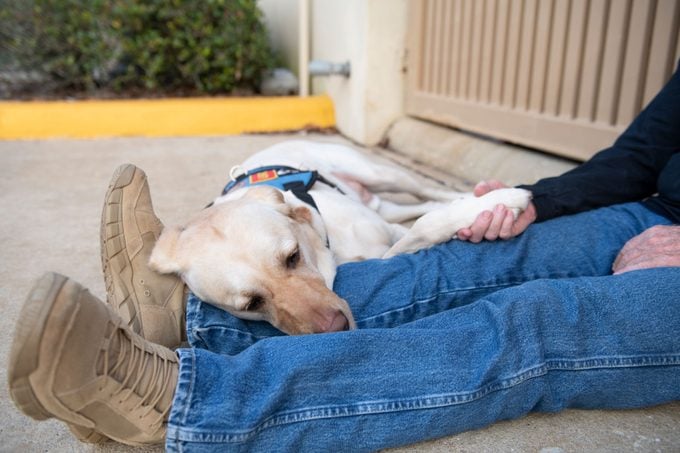How Blue, the Big Yella Fella, Helped Turned This Veteran’s Life Around
Updated: Sep. 01, 2023

Military service and decades of humanitarian work left Robert MacPherson with PTSD. Blue helped him accept and overcome it.
Editor’s Note: America’s Best Pet Pals is a nationwide search for the animal friendships that make you laugh, cry, and purr. Reader’s Digest honors the best in pet friendship in print, online, and on social media. This is the winner in our “Lifesavers” category. To see winners in other categories and our full list of finalists, go to rd.com/petpals.
My dog, Blue, came into my life because I have post-traumatic stress disorder (PTSD). For me, it’s a cumulative result of three significant conflicts as an infantry Marine and 20 years of humanitarian work beginning in Somalia, through the Bosnian War, genocide in Rwanda, Darfur, Haiti, Iraq, and Afghanistan.
PTSD is a soul-crushing illness, dragging its victims into nightmarish voids of shame, fear, and chaos. After being diagnosed, I wandered through denial, anger, and self-pity. The deeper the illness’s invasion, the more isolated, reclusive, and angry I became. Finally, I was left with two choices, give in to its malignancy, or find my way back to the calm person who was still inside. I could rage, bargain, pray, beg—it didn’t matter. There was only one path home: help.
In therapy at the Veterans Administration, a friend suggested I consider a service dog. At first, I was ambivalent, but the idea grew. I looked at several organizations and was impressed by the two years of training to become a certified PTSD service dog. However, I dismissed the idea because I thought the cost for such an animal was out of my league. Then, I discovered if a veteran is in a treatment program for PTSD, many of the training organizations will provide the dog at no cost.
Even with the prospect of having a trained companion, my hesitancy was a clash between ego and reality. I felt walking around with a large dog with a vest announcing “service dog” was a public admission of an illness I wanted to hide. It was the motto on the Southeastern Guide Dogs website that hit home: “serving those who cannot see and those who have seen too much.” Mitigating PTSD involves learning to accept the past; the phrase “who have seen too much” fits.
Their application process was straightforward. After a background check, contacts with references, a review of my military record, and verification of a treatment program, I was visited by a Southeastern Guide Dog trainer.

Katie walked through my front door with a Labrador named Sal, and the three of us spent the afternoon walking in the neighborhood while Sal and I interacted with each other. If I was accepted into the school, Sal would not be my dog. His task was to help Katie with the home visit and watch my interaction with a dog.
At the end of the day, Katie asked, “why do you want a service dog?” I hesitated for a moment and stated the obvious, “because I have PTSD?”
RELATED: How the Dog Nobody Wanted for 17 Months Became a School’s Unofficial Mascot
She smiled and said, “come on, why do you want a service dog?” I was ashamed to admit the truth. “Because I need help—I’m not even sure what that looks like, but there is a part of me saying it can be found in the dedicated companionship of a service dog.”
Katie sat quietly for a moment and then asked several questions about my preference for color or gender. I was open to any dog until she asked if I had any requests. I answered, “Imagine standing in the exercise area for the dogs and in the distance, one dog is romping with his friends. You’ve been concerned about ever placing him. He’s huge! His size will fill up a house, apartment, car, or truck! That’s my dog!”
On a day in March, I arrived at the Southeastern Guide Dogs campus in Palmetto. The sun was shining, and a calm wind nurtured the “just right” temperature. The grounds included a large dorm and meeting rooms for students, lounges, kennels and play areas for the dogs, veterinarian buildings, training facilities, and administrative offices. Throughout the campus were walkways, quiet paths, small ponds, and lovely gardens. The characterization that came to mind was “peaceful.”
On the first evening, I met my classmates: three Marines, three soldiers, and an airman. Our three-person group of trainers welcomed us and outlined the coming days while reminding us of our attendance rules. There was no alcohol or recreational drugs; we could use cell phones but were restricted to campus unless accompanied by a trainer. No visitors were allowed. None of this was new; the details were part of the contract we signed with the school. After reviewing the training schedule and curriculum, one of the staff described each of our dogs. Finally, she looked at me, “Since the beginning of this school in 1984, your dog is the largest Lab ever born in this facility. Bob, you’ll meet him tomorrow.”

After breakfast the following day, we were asked to return to our rooms and wait in the oversized chair facing the door. A trainer would bring our dog to the door, knock, and ask us to give the cue, “come.” The trainer would open the door and allow our dog to greet us. While sitting in the chair, waiting for my turn, I was shocked by my emotion. I heard the dogs being introduced to their veterans while coming down the hallway toward my room. As they got closer, my throat tightened, and my heart thundered.
The loud knock on my door sent a shudder of apprehension through my body. This was it; he was here. I yelled, “come,” and an enormous yellow dog charged into my life. In a flash, a 90-pound yellow Lab with ears the size of dinner plates crossed the 25 feet between us in a flicker of consciousness. I dropped to the floor, and my face was scrubbed by a wet tongue moving in sync with an ever-wagging tail. At that moment, my worry vanished, and I fell in love with the big yella fella.
Blue was trained for 23 months before we met and knew his job. Over the next 12 days, the training focused on understanding his abilities, temperament, and bonding with him. We were together 24 hours each day. The trainers emphasized our relationship was based on the dog’s constant presence. When I moved, he moved. If he was sleeping next to me and I stood, he followed me. If he could not physically follow, he wanted to maintain line-of-sight with me. When I entered a room without him and closed the door, he never made a sound but sat or lay until I appeared. His degree of loyalty intimidated me because I did not feel worthy of such trust and allegiance.
On my fifth night, I had a terrifying dream. For the past two years, they were becoming more frequent, and the panic increasingly severe. While still in the nightmare, I was suddenly aware of pressure across my chest. Panicking, I shot up in bed, gasping for air and trying to orient myself. In my terror, I looked to the right and saw Blue’s intense gaze and realized he had placed his legs across my chest. He tried to gently restrain me while waking me by licking my face. As I quieted, he lay his head on my chest, and I began to match the rhythm of his breathing. I could feel his warmth and kindness begin to replace the dark memories that invaded my nights.

The cues Blue learned over two years are impressive. He inconspicuously blocks people from invading my personal space and scans our environment to judge where to place himself as others approach. While never aggressive, he gently guides me through crowds or moves to watch my back if I stop to engage in conversation or stand in a line. All examples of learned skills, but over our time together I’ve learned he has natural abilities that cannot be taught.
Blue is an empath and deeply aware of another’s feelings, which he embraces as his own. He feels pain points by sensing feelings in ways not explained by conventional science or psychology. His learned responses to my PTSD are impressive, but his manner of assisting me that developed our three years together is beyond remarkable.
Now, he intercedes before I realize I am falling into depression, anxiety, or anger. His manner is never aggressive or assertive. At times, he simply comes to me wagging his tail. If he feels I’m pushing my body too hard at the YMCA, he moves as close as he can get to a weight or exercise machine and licks my leg or arm. When he perceives too much stress on a phone call or conversation, he lays his head across my leg or lap. Now, on the rare occasion when I vocalize anger, he sits, stares at me with a face saying, “I don’t know what to do, but I love you.” That look and his body language immediately short-stops the anger from escalating.
Blue has guided me back to a path of renewed engagement in life and calmness that has made me a better person. With him, I found the freedom and creativity to embrace life rather than endure it. As my mind calmed, so has my body. I have regained some of the health that was lost in the trauma of PTSD.
My life is not perfect; I still have bad times, but it’s different. We acknowledge rather than hide the depression and work through it together. The journey is now a quiet acceptance of the illness and its source without anger, fear, shame, or resentment. But the path has been guided by something intangible, only seen when I look into Blue’s eyes.
There, just for a fleeting moment, I catch a glimpse of the deeper story of his existence, forged by unconditional love and a soul created to heal. Through his dark eyes, I see love and faith that are both humbling and inspiring. As I feel the warmth of his gentle gaze and feel the weight of his head resting on my knee, I thank him for giving me my life back.